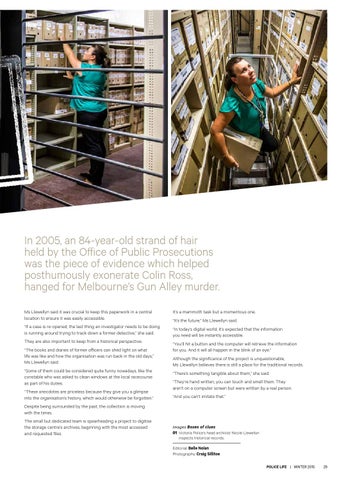In 2005, an 84-year-old strand of hair held by the Office of Public Prosecutions was the piece of evidence which helped posthumously exonerate Colin Ross, hanged for Melbourne’s Gun Alley murder. Ms Llewellyn said it was crucial to keep this paperwork in a central location to ensure it was easily accessible.
It’s a mammoth task but a momentous one.
“If a case is re-opened, the last thing an investigator needs to be doing is running around trying to track down a former detective,” she said.
“In today’s digital world, it’s expected that the information you need will be instantly accessible.
They are also important to keep from a historical perspective.
“You’ll hit a button and the computer will retrieve the information for you. And it will all happen in the blink of an eye.”
“The books and diaries of former officers can shed light on what life was like and how the organisation was run back in the old days,” Ms Llewellyn said. “Some of them could be considered quite funny nowadays, like the constable who was asked to clean windows at the local racecourse as part of his duties. “These anecdotes are priceless because they give you a glimpse into the organisation’s history, which would otherwise be forgotten.”
“It’s the future,” Ms Llewellyn said.
Although the significance of the project is unquestionable, Ms Llewellyn believes there is still a place for the traditional records. “There’s something tangible about them,” she said. “They’re hand written, you can touch and smell them. They aren’t on a computer screen but were written by a real person. “And you can’t imitate that.”
Despite being surrounded by the past, the collection is moving with the times. The small but dedicated team is spearheading a project to digitise the storage centre’s archives, beginning with the most accessed and requested files.
Images Boxes of clues 01 Victoria Police’s head archivist Nicole Llewellyn inspects historical records. Editorial: Belle Nolan Photography: Craig Sillitoe POLICE LIFE | WINTER 2015
29
